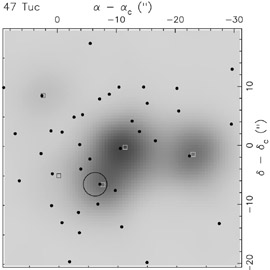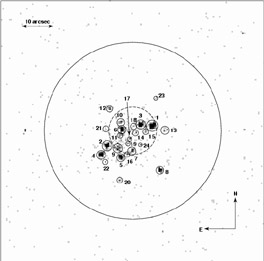


As already mentioned, a limited number of low-luminosity sources has
been detected
with Chandra in several clusters which contain a luminous X-ray source. The
presence of such a source limits the sensitivity with which
low-luminosity sources can be detected, because of the wings of the
point spread function. The sharp (< 1") images and high sensitivity
of the Chandra observations is best used in clusters which do not
contain a luminous source. Such observations show that the central
regions of several globular clusters contain dozens of sources.
As a typical example, the distribution of the
sources in NGC6440 is concentrated towards the cluster center;
while it spreads beyond the core radius, it is fully contained within the
half-mass radius (Figure 8).
From this spatial distribution alone, it can be
safely asserted that almost all sources detected are related to the
globular cluster. In clusters with large core radii
and/or half-mass radii, a larger fraction of the detected sources may be
fore- or background sources; an example is
 Centauri.
Centauri.
 |
 |
Figure 8. Top: The impact of Chandra on
the study of low-luminosity X-ray sources in globular clusters is well
illustrated by the observations of
47 Tuc. The grey scale of the smoothed ROSAT-HRI
countrate indicates the resolution obtained with this instrument
(Verbunt & Hasinger
1998).
The circle indicates the position
(1 |
In trying to determine the nature of all these X-ray sources, we may be guided by our knowledge from previous satellites, in particular ROSAT. Such guidance allows us to make a preliminary classification of a source based on its X-ray flux and spectrum. If a secure optical counterpart is found - which thanks to the accurate source positions delivered by Chandra is often the case whenever sufficiently deep HST observations are available - the classification of a source can be further based on its optical spectrum, and on the ratio of the X-ray and optical fluxes. A secure classification can also be found if the position of a radio pulsar coincides with that of an X-ray source: radio and X-ray positions are so accurate that the probability of a chance coincidence is virtually negligible for these rare objects.
Our discussion of the low-luminosity sources proceeds through the various classes illustrated in Figure 1, viz. low-luminosity low-mass X-ray binaries, recycled radio pulsars, cataclysmic variables, and magnetically active close binaries. An overview of published Chandra observations of low-luminosity sources in globular clusters is given in Table 4.
| cluster | ref | Llow | BX | FX | CV | PSX | (PSR) | BY | Ntot | ||||
| NGC6440 | [176] | 2 × 1031 | 1 | 3 | (1) | ||||||||
| NGC6652 | [89] | 8 × 1032 | 1 | 3 |
 1? 1? |
||||||||
| Terzan1 | [238] | 3 × 1033 | 1 | 1 |
 1? 1? |
||||||||
| Terzan5 | [90] | 5 × 1032 | 1 | 4 | 5 | (4) | |||||||
| Liller1 | [105] | ~ 1034 | 1 | 3 | |||||||||
| 47Tuc | [78] | 1030 | 0 | 2 | >30 | 15 | (22) | 26 | 104 | ||||
 Cen Cen |
[62] | 1031 | 0 | 1 | >20 | (0) | 4 | ~ 100 | |||||
| NGC6093 | [92] | 7 × 1030 | 0 | 2 | ~ 15 | 19 | |||||||
| NGC6121 | [13] | 1 × 1029 | 0 | 0 | 3 | 1 | (1) | 14 | ~ 20 | ||||
| NGC6205 | [63] | 2 × 1031 | 0 | 1 | 4 | 0 | (5) | 5 | |||||
| NGC6397 | [79] | 3 × 1029 | 0 | 1 | 9 | 1 | (1) | 3 | ~ 20 | ||||
| NGC6626 | [14] | 2 × 1030 | 0 | 1 | ~ 25 | 1 | (1) | ||||||
| NGC6656 | [232] | 0 | 1? |
3 | ~ 3 | ||||||||
| NGC6752 | [175] | 2 × 1030 | 0 | 0 | 10 | 1 | (5) | 3 | 17 | ||||